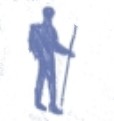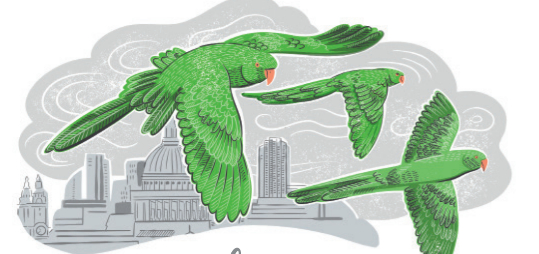Published in The Simple Things
January 2024
You’ll probably hear them before you see them: a startling, abrasive screech that cuts through the roar of traffic. Your first glimpse might only be a flash as they zoom through foliage or turn at the corner of the street, as purposeful as commuters. But if you can get close to one – and I’d recommend that you do, perhaps by feeding it an apple from your hand – you will see that the tone of their feathers is not uniform, but ranges from acid green to the glow of sunlight through a leaf. Their small, hooked beaks are as orange-red as overripe papaya. The ‘rose-ring’ of their name refers to a band of gorgeous pink, and their eyes are startling blue, encircled by hypnotic loops of Day-Glo orange.
One day in 1968, Jimi Hendrix walked down Carnaby Street with a birdcage in his hands. The cage contained two rose-ringed parakeets named Adam and Eve. Hendrix opened the cage door and the parakeets flew out, streaks of psychedelic green against the grey London sky. Adam and Eve made love, not war – today the capital contains 50,000 of their descendents.
That story is not true, of course. Neither is the one about London’s parakeet population escaping from the film set of The African Queen in the 1950s, or the one about them fleeing George Michael’s house during a burglary. The likelier, but less colourful, theory is that dozens or hundreds of pet birds slipped their cages over the years, and quickly found their niche in London’s parks and cemeteries, coming together in garrulous roosts and spreading
throughout the city. But who wants truth when you can have urban myths as rich as these?
Today it’s not just Londoners for whom these brash South Asian birds have become almost as common a sight as urban pigeons. The Big Smoke is too small for them, and in recent years they have spread to almost every county in England, and established colonies as far north as Edinburgh and Glasgow. People often assume they must be cold, but given that their native range extends to the foothills of the Himalayas it seems that English and even
Scottish winters are temperate enough. Smart, resourceful and adaptive, they have proved highly successful as an invasive species.
In terms of their impact on native birds, while they might outcompete certain species in some areas – woodpeckers for access to nesting sites, tits for food on bird tables – the consensus among ecologists is that it’s too early to tell. For now, at least, there is plenty of food and greenery to go round. Despite occasional predictions of an impending cull, the government have quietly admitted that parakeets are here to stay. Like grey squirrels and muntjac deer, they are already part of the British landscape.
They have made great inroads into British culture, too. Their image has been adopted on pub signs, a brewery logo and a women’s rugby team – what greater symbols of integration into British life could there be? So next time you hear a screech as harsh as Hendrix’s guitar, look up for that startling flash of green. It might be another urban myth just waiting to be told.
Illustration by Zuza Misko


